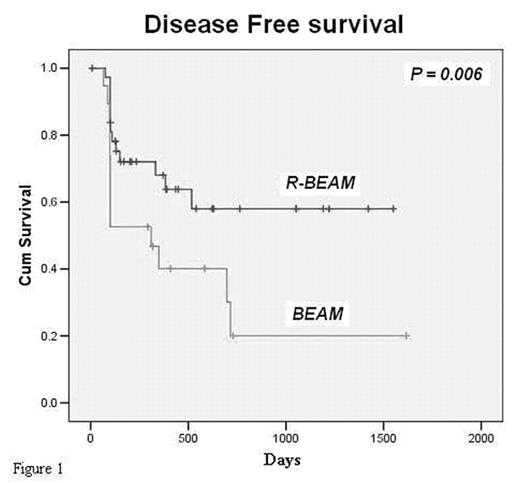Abstract
Background: Refractory or relapse B-NHL has a poor prognosis with conventional chemotherapy. Autologous stem cell transplant (ASCT) preceded by high dose chemotherapy has been the preferred therapeutic choice for such patients. The majority of the treatment failures occur within one to two years post transplant with disease progression after transplant accounted for most of the failures. The incorporation of targeted immunotherapy (rituximab) into the upfront and relapse setting is becoming of the standard of care for patients with B-NHL. The objective of this study is to evaluate the impact of rituximab (R) on disease free survival (DFS) when added to a standard conditioning regimen -- BEAM (carmustine, cytarabine, etoposide, and melphalan) prior to ASCT.
Methods: A single institution retrospective analysis of 53 patients (pts), whom were heavily pre-treated, underwent ASCT between 08/98 & 07/06. All pts received rituximab in combination with high dose cytoxan for stem cell mobilization. 37 pts received R-BEAM and 16 received BEAM prior to ASCT. Actuarial rate for DFS was estimated from the day of SCT using the Kaplan-Meier method.
Results: The group was predominantly men, 73% and 78%, with a median age of 57 years for both the R-BEAM and BEAM group. With a median follow up of 15.7 months, 13/37 (32%) and 11/16 (64%) pts who received R-BEAM and BEAM respectively developed disease progression after ASCT. The 2-yr actuarial disease-free survivals (figure1) were 60% and 21% for the R-BEAM and BEAM arm respectively (p=0.006).
Conclusion: In this study, the outcome of pts who received R-BEAM compares favorably to those who receive BEAM alone with significant improvement in disease-free survival. Thus, incorporating target immunotherapy into standard conditioning regimen may have altered the natural history of the disease for pts undergoing ASCT for relapsed/refractory B-NHL.
Disease Free survival
Author notes
Disclosure: No relevant conflicts of interest to declare.


